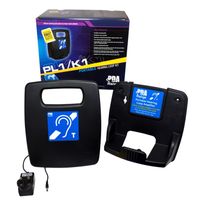Hearing Loop
You can find quality hearing loop systems here at YESSS Electrical. Hearing loop systems are a simple yet highly effective solution for improving communication in public and shared spaces. Designed to support those with hearing loss, a hearing loop transmits audio signals directly to a user’s hearing aid or receiver, reducing background noise and enhancing the overall listening experience.
Also known as audio induction loops or audio frequency induction loops, these assistive listening systems work by transmitting a magnetic signal from a sound source through a loop cable, which is connected to a loop driver.
This signal is then picked up by the telecoil setting in a compatible hearing aid or neck loop.
A hearing loop consists of a microphone to capture speech, an amplifier to process the sound, and a loop of cable that sends the signal to users. Systems can be installed in a variety of settings, including meeting rooms, lecture halls, reception desks, places of worship, concert halls and other public spaces where equal access is essential.
A hearing loop system will also customise the sound to each user’s specific hearing device. Getting a hearing loop system fitted in your building can show visitors that you are accommodating to those with hearing difficulties.
These systems offer a cost-effective and proven way to benefit users, especially when compared with more complex or alternative technology. Clearer speech, better performance in noisy settings, and enhanced access to key services are just a few of the advantages.

Portable Hearing Loop System with Wall Mounting Storage Shelf, 1.2m²
FAQs
How do hearing loops work?
Hearing loops transmit sound directly to hearing aids using a magnetic signal. This reduces background noise and makes it easier for users to hear clearly, especially in busy or echo-prone environments.
What equipment does a hearing loop system consist of?
A typical system includes a microphone, loop driver and loop cable. These work together to transmit sound from a source directly into compatible hearing aids or receivers.
Where can hearing loop systems be installed?
They’re suitable for a wide range of public and private spaces, including reception desks, meeting rooms, lecture halls, places of worship and concert venues.
Do all hearing aids work with hearing loops?
Most modern hearing aids are compatible if they have a telecoil (T-coil) setting. Users can activate this setting to receive the audio signal directly from the loop system.
What is the benefit of using a hearing loop over other assistive listening systems?
Hearing loops offer a discreet, user-friendly solution without the need for additional devices. They’re ideal for ensuring equal access and improving communication in shared spaces.
Is a hearing loop system easy to install?
In their simplest form, many systems are straightforward to install, especially in smaller rooms or one-to-one settings. For larger or more complex installations, professional advice is recommended.
Can I use a hearing loop in a large space like a concert hall?
Yes, large area loops are designed specifically for wide coverage and are commonly used in concert halls, theatres and auditoriums to support multiple users at once.
How can I ensure the system provides good performance?
Proper installation, using the correct loop driver and ensuring the loop cable is fitted appropriately, will help maximise signal strength and audio clarity.
What’s the difference between an induction loop and a neck loop?
An induction loop is installed in a room and covers a defined area, while a neck loop is worn around the neck and connects to portable devices, offering flexibility in mobile settings. Our range includes a portable hearing loop system.
Do hearing loop systems require ongoing maintenance?
They should be checked regularly to ensure they are functioning correctly, especially in busy public settings. Routine testing ensures users receive reliable performance when they need it.


